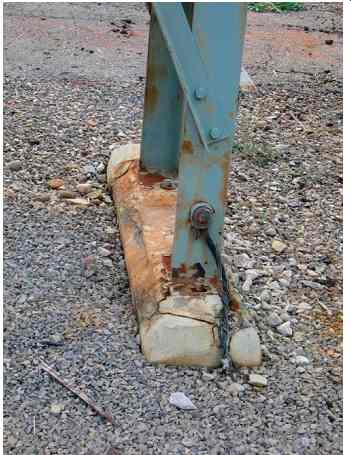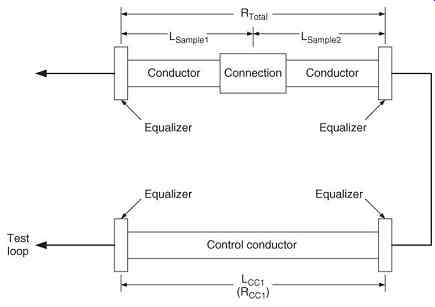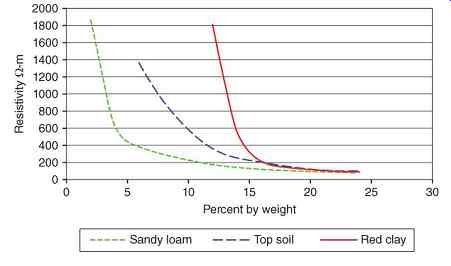AMAZON multi-meters discounts AMAZON oscilloscope discounts
[Note: various equations denoted by "e." are not yet avail., but coming soon.]
1. Introduction
However well a grounding system is designed, inevitably changes in the power system, deterioration of materials, environmental changes, and equipment failure will decrease the inherent safety of the original system. It is important to perform regular inspections, maintenance, and testing of any system to ensure its continued safety. This is especially true of grounding systems because of their exposure to the elements, unwanted human and animal damage, and to electrical events such as lightning strikes, overloads, and short circuits.
This is to emphasize that safe design is not the end of the safety process, but only the beginning. Equipment and installations must remain electrically safe throughout their entire useful life, until their final de-energization and demolition changes the nature of the hazards to other than electrical.
It is crucial for the user to be aware of ground-fault current magnitude at the service entrance to their premises. The protection that ground grids provide against step and touch potentials is only good up to the expected level and duration of ground fault currents, as originally communicated by the electric utility in the design phase. Higher current to ground can cause malfunctioning and damage of equipment as well as diminish system reliability. Unexpected high fault currents can also produce thermal and mechanical damages to a customer's ground grid and ground grid connections with consequential permanent loss of effectiveness of the same (Mitolo, Sutherland, and Natarajan, 2010a). In order to prevent these problems from occurring, a ground grid assessment utilizing updated data should be carried out on a regular basis. This Section is adapted from EPRI (2006).
2. Effects of High Fault Currents
There are many possible causes for increased ground potential rise (GPR) in substations (IEEE, 2000) which may be aggravated by high fault currents:
1. drying of the soil, increasing the ground resistance;
2. excessive voltage drops in the conductors and connectors due to high currents;
3. fusing, melting, and connector failures;
4. arcing, burning, and open circuits;
5. altered current flow paths, further increasing voltage drops;
6. corroded or otherwise damaged conductors and connectors (examples from a high voltage substation are shown in Figures 1- 3);
7. thinning of the protective surface layer of crushed stone or gravel;
8. weeds and shrubs growing in surface layer (an example from a high voltage substation is shown in FIG. 4);
9. mixing of the surface layer with soil and dust, decreasing its resistivity;
10. failure of static wire, ground, or neutral wire connections from transmission and distribution lines to the substation.
11. reduction in electrical safety causing increased step and touch potentials.

FIG. 1 Deteriorated grounding conductor and cracked concrete foundation.

FIG. 2 Deteriorated grounding conductor, broken concrete support, and insulator
debris.

FIG. 3 Deteriorated grounding conductor and broken insulator debris.

FIG. 4 Vegetation and deteriorated concrete.
The mechanisms by which these and other factors can cause injury or death are the step and touch potentials. First, the ground resistance is calculated using Sverak's equation (IEEE, 2000, p. 65):
3. Damage or Failure of Grounding Equipment
3.1 Thermal Damage to Conductors Due to Excessive Short-Circuit Currents
An increase in fault current will decrease the fusing time of the grid conductors:
eq.5 where
= fusing time of the conductor in
= conductor cross sectional area in kcmil
= rms symmetrical fault current in kA (It is assumed that the symmetrical rms fault current from the ground fault calculations for the substation).
…is the material-fusing constant. Typical values are 7.00 for soft-drawn copper, 10.45 for 40% conductivity copper-clad steel wire, and 15.95 for a steel conductor.
is the decrement factor, used when fault durations are less than 1 s or the ratio is greater than 5.
Examples of fusing current calculation results are shown in Table 1. It is recommended that the ground grid conductor thermal limit be plotted as a point on a time-current curve, FIG. 5, and an line be extended upward from it to represent the ground grid thermal damage curve. If this curve is exceeded, the conductors may be subject to fusing, melting, or other forms of thermal and mechanical damage.
A vertical line may represent the mechanical damage curve.
Table 1 Test Currents and Fusing Currents for Annealed Soft-Drawn 100% Conductivity Copper Conductors

FIG. 5 Typical time-current curves showing thermal and mechanical withstand
for 500 kcmil copper ground grid conductors (assuming 0.5 s fault-clearing
time) and connectors.
3.2 Connector Damage Due to Excessive Short-Circuit Stresses
This primarily affects permanent connections.
Grounding grid connections should withstand short-circuit electromagnetic forces up to the 1.0 s fusing current of the conductors to which they are attached, and heating from fault currents for up to 90% of the fusing current for 10s.
The test specifications in IEEE Standard 837-2002 (IEEE, 2002a) call for the construction of a control conductor, as shown in FIG. 6, of length and resistance.
A test loop containing up to four connector assemblies under test is assembled. Each connector assembly consists of two conductor samples. If the conductors are stranded, then equalizers must be used at each end where a connector is not in place. The purpose of the equalizers is to establish an equipotential plane across the ends of the conductor strands.

FIG. 6 Short-circuit testing of ground grid connectors. The test loop contains
one through four connector assemblies.
The electromagnetic force test applies an asymmetrical waveform with the specifications listed in Table 2. The sample resistance after the first test is not to exceed 110% of and 150% after three tests. The fusing test applies a symmetrical fault current, as listed in Table 2, repeated three times. The evaluation of the test consists of disassembly and dissection of the connection and inspection for signs of melting or other damage. Results of example calculations are shown in Table 1. As long as the fault magnitude and duration fall under the two points defined by these tests, as listed in Table 2, there should be no failures of connectors due to excessive fault currents.
==========
Table 2 Fault Current Tests for Connectors
===========
3.3 Drying of the Soil Resulting in Increased Soil Resistivity
A current density of less than for 1 s is recommended. Heating of soil whose temperature is above the freezing point has negligible effect on its resistivity. The effect of moisture content on soil resistivity is given in the IEEE Green Book (IEEE, 2007a) for several soil types. Resistivity is quite constant above 22% moisture content, but increases dramatically below that. FIG. 7 shows this effect for three different types of soil.
Experimental test results from Georgia Power show significant variation in ground grid resistance with the seasons, but little change when the integrated ground resistance including the transmission line shield wires was considered (EPRI, 1992).

FIG. 7 Effect of moisture content on soil resistivity.
Without performing three-dimensional electromagnetic simulations, there is no easy way to calculate the drying of soil by the passage of electrical current and the consequent increase in resistivity.
4. Recommendations
In order to prevent these effects, the following regular recalculation of ground grid parameters should be made in addition to normal ground grid maintenance, to ensure that fault current levels are not exceeded:
1. ground resistance measurements;
2. short-circuit calculations, usually done with specialized software;
3. recalculation of step and touch potentials, usually done with specialized software.
There are various measures that can be taken to reinforce a ground grid. These include
1. adding ground grid conductors, decreasing the spacing of conductors;
2. increasing the area of the grid;
3. adding parallel conductors around the perimeter of the ground grid;
4. adding ground rods, with closer spacing at the perimeter;
5. diverting fault currents to other paths;
6. limiting total fault current;
7. barring access to hazardous areas;
8. connecting overhead ground wires from transmission lines;
9. decreasing tower-footing resistances;
10. reinforcing or replacing connectors between above-ground components and the ground grid;
11. increasing thickness of upper layer of crushed stone;
12. using soil treatment to lower resistivity;
13. using deep ground wells, which may be useful when ground rods are not effective.